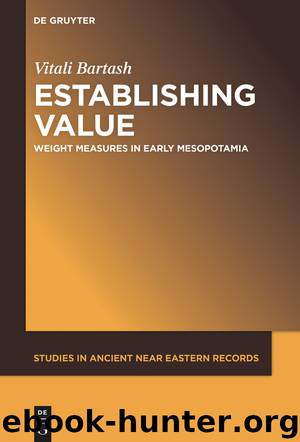Establishing Value by Vitali Bartash

Author:Vitali Bartash
Language: eng
Format: epub
Publisher: Walter de Gruyter
Published: 2019-05-25T16:00:00+00:00
8.4 Conclusions
The 3rd millennium BC cuneiform documents from Lower Mesopotamia offer rich data on weighing balances and their construction. The discussion of the Sumerian word for “balance” (ĝeš-rin2) relates it to the word for “yoke.” Therefore, strictly speaking, ĝeš-rin2 is “weighing balance” and not “scale(s),” which is dilim2 in Sumerian.
Six terms designating such balances are documented in 3rd mill. BC records. They differed in their capacity, construction, and the types of goods they were supposed to measure. Hence, one can speak about balances of different “standards” in the pre-Ur III records. This phenomenon emphasizes the fact that the standardization of the weight measures involved not only the regulation of stone weights but also of other weighing gear.
The Presargonic texts from Ĝirsu document two weighing balances: (1) ĝeš-rin2-siki “balance (to weigh) wool” and (2) ĝeš-rin2-uruda “balance (to weigh) copper.” The attributes “large” and “small” with the balance for wool refer most likely to their size and, consequently, to their capacity. Weighmasters used the standard weights for textiles and wool (na4-ša3-tug2) to operate the wool scales. The lightest stone was one mina and the heaviest was 40 minas.
The dishes of the copper scales were called ĝešgab-il2 in these Presargonic Ĝirsu texts. Weighmasters used these scales together with the weights of the regular standard (na4-si-sa2) of up to 60 minas.
Ur III texts record the balances of the capacities “one talent” and “30 minas.” These balances seem to have had only one dish while the second arm was occupied with a permanently attached large weight. Such balances were especially useful in industries where not the precision but the rapid measurement of large amounts of less valuable goods mattered: wool and flax. These heavy scales rested on stands (ĝešKIB) made from various types of wood.
Ĝeš-rin2-gaba is another type of wool scales that appear in Ur III records. It is certain that it does not designate handheld scales. In contrast, this type is likely hiding behind the term ĝeš-rin2-ku3(-la2) “balance scales (to weigh) silver” that appears in Sargonic and Ur III records.
The terms ĝeš-rin2-uruda(-la2) “balance (to weigh) copper” and ĝeš-rin2-ku3(-la2) “balance (to weigh) silver” corraborate the theory that these two metals were originally measured by different “standards,” using different sets of weights. The Sargonic data on the “stone for silver” discussed before may be another piece of the same jigsaw.
The common term for balance pans was dilim2. Documents tell us that they were made of various types of copper and bronze. In contrast, balances were mostly manufactured of timber and were strengthened with copper or bronze parts, inlays, or wire.
Some terms that appear in the later lexical tradition do not appear in the extant early data. This is the case with ĝeš-rin2 lub-lub-bi (a type of scales), a2 “arm (of the balance),” and e2 “box (of the balance).” However, new data and further work on this topic may change this situation.
The context in which these weighing implements appear is the same as with the stones: large central households and elite private households. The context suggests their use was mostly in the textile industry.
Download
This site does not store any files on its server. We only index and link to content provided by other sites. Please contact the content providers to delete copyright contents if any and email us, we'll remove relevant links or contents immediately.
| Africa | Americas |
| Arctic & Antarctica | Asia |
| Australia & Oceania | Europe |
| Middle East | Russia |
| United States | World |
| Ancient Civilizations | Military |
| Historical Study & Educational Resources |
Empire of the Sikhs by Patwant Singh(22762)
The Wind in My Hair by Masih Alinejad(4839)
The Templars by Dan Jones(4556)
Rise and Kill First by Ronen Bergman(4543)
The Rape of Nanking by Iris Chang(4021)
12 Strong by Doug Stanton(3418)
Blood and Sand by Alex Von Tunzelmann(3055)
The History of Jihad: From Muhammad to ISIS by Spencer Robert(2504)
Babylon's Ark by Lawrence Anthony(2427)
The Turkish Psychedelic Explosion by Daniel Spicer(2245)
No Room for Small Dreams by Shimon Peres(2235)
Gideon's Spies: The Secret History of the Mossad by Gordon Thomas(2230)
Inside the Middle East by Avi Melamed(2230)
Arabs by Eugene Rogan(2193)
The First Muslim The Story of Muhammad by Lesley Hazleton(2153)
Bus on Jaffa Road by Mike Kelly(2034)
Come, Tell Me How You Live by Mallowan Agatha Christie(2024)
Kabul 1841-42: Battle Story by Edmund Yorke(1921)
1453 by Roger Crowley(1879)
